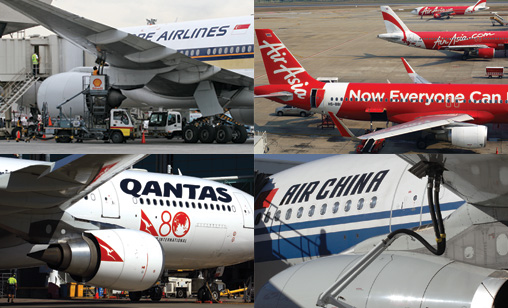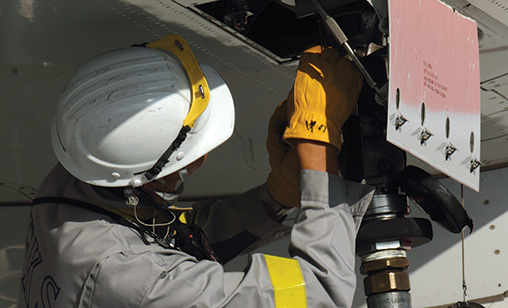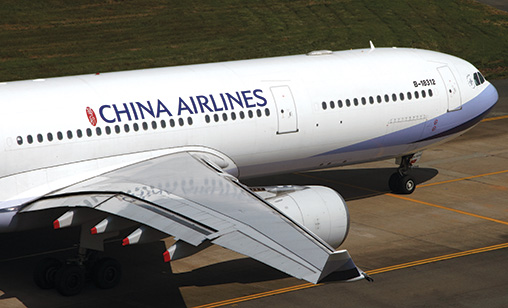Main Story
Risky business
The knock-on effects of cheap oil for Asia-Pacific airlines are emerging as the industry’s reporting season moves into full swing. Some carriers are reporting rocket charged profits, especially if they had not hedged their fuel at past high prices, but that is only part of the story. Chief correspondent, Tom Ballantyne, reports on the impact $30 a barrel oil is having on the region’s airlines.
March 1st 2016
Fuel is the life blood of the airline industry and its biggest cost. It also can be its Achilles Heel as past, extremely elevated aviation kerosene prices have demonstrated. Read More » This year, a barrel of oil will be the cheapest it has been in 12 years and airline profit margins will be the highest they have been for more than 50 years.
But it is becoming apparent that cheap oil can have its downside for in the Asia-Pacific, even at the best run Asia-Pacific carriers.
 |
In the latest financial monitor of the International Air Transport Association (IATA), it was reported that crude oil prices dropped to a 12-year low in January. The triggers for the decline were weaker global demand and concerns over excess supply, including the additional barrels of crude being pumped out of Iran.
“If sustained,” said IATA, “the most recent declines in oil prices would reduce the industry’s annual fuel bill by approximately $12 billion in 2016.”
That has to be good news for the airline industry, but for many carriers it’s a long way from a financial windfall. Overall, lower fuel costs may be pumping up profits but the reality is that Asia-Pacific airline profitability is lagging behind other regions. Asia-Pacific carriers are expected to grow earnings to $6.6 billion in 2016, from $5.8 billion last year, according to IATA.
Average forecasts for overall profit per passenger is $5.13 in Asia, well behind the U.S. and Europe, where profit per passenger is expected to be $21.44 and $8.80, respectively.
Asian carriers’ managers “are working to overcome these challenges”, IATA’s Tyler said. “It’s hard to say when things will improve. It’s going to take a little bit of time to recover in terms of profitability.” Whether the improvement continues to gather pace or suffers another setback won’t only depend on managements continuing to introduce operational improvements and efficiencies but if the price of oil remains stable at relatively low levels,” he said.
IATA pointed out the hedging policies of a large number of airlines have fixed their fuel costs at earlier, higher prices, so there will be a delay in benefiting from cheaper oil.
An example is Singapore Airlines (SIA).The carrier posted a net profit of US$196 million for its third quarter, ending 31 December 2015, up 36% compared with the $144 million profit it reported in the same period a year earlier.
The better results were largely due to a 24% drop in the company’s fuel costs plus gains from the sale and lease back of some SIA aircraft. But they could have been better.
As principal analyst at Malaysia-based Endau Analytics, Shukor Yusof, explained, the SIA profit report contained other key numbers for the quarter. Operating profit was up $205 million, but losses from jet fuel hedges were $51.3 million. Foreign exchange (forex) losses came in at round $55 million.
 |
Said SIA in its official results statement: “While more relief could arise from lower fuel prices, which have declined to a 12-year low, fuel continues to make up a significant portion of the Group’s expenditure, with 46.6% of the Group’s fuel requirement in the fourth quarter hedged at a weighted average price of $90 per barrel.”
That, said Shukor, is quite a significant volume hedged at prices well above the current levels of jet fuel per barrel (between $35 and $33 per barrel at press time).He said a sharp rise in oil prices accompanied by more weakening of the Singapore dollar would raise costs and put more pressure on margins.
While SIA is far from being alone in having fuel hedged at prices well above the current spot price for some months to come, other issues that could alter airlines’ strategies, because oil is so cheap, have emerged.
Analysts are asking if cheap fuel will encourage airlines to keep older aircraft flying longer and postpone or delay deliveries of costly new fuel-efficient jets.
As well, airlines have been criticized for keeping fuel surcharges in place in a cheap oil environment and accused of profiteering by not passing on fuel price reductions in the form of cheaper fares.
“It is nonsense,” said Tyler. “It is simply not the case that anyone is profiteering. While fuel is still a big element of airline costs, there is still a huge chunk that is not affected, so to expect fares to tumble just because fuel has come down is wholly unrealistic.”
Speaking at an aviation summit on the eve of the February air show in Singapore, Tyler said industry profitability remained fragile despite the record $36 billion global airline industry profit forecast for 2016.
“Certainly, lower oil prices have helped, but that impact has been delayed and diluted in many parts of the world due to forward hedges at higher than market rates and the rise of the U.S. dollar against local currencies.
“As costs come down so will fares, and the public is getting an extremely good deal from the industry right now,” he said. Airlines argue they are only starting to develop a sustainable profit for their investors due to high capital costs, regulatory constraints and intense competition.
| 'Overall, the lower fuel costs may be pumping up profits but the reality is that Asia-Pacific airline profitability is lagging other regions. Asia-Pacific carriers are expected to grow earnings to $6.6 billion in 2016, from $5.8 billion last year' |
| International Air Transport Association |
Tyler pointed out that the majority of this year’s industry profits, or $19.2 billion, will be generated in North America and he warned again about the profitability of carriers in Southeast Asia, home to cut-throat competition between low-cost carriers.
While fuel has fallen, the dollar has risen by 20% against regional currencies in the last 18 months, he said.
Despite the fuel surcharge criticisms and the claims of profiteering, IATA statistics clearly show airfare levels have been falling. In the first 11 months of 2015, they decreased 12% year-on-year. Even adjusting for the impact of an appreciation of the US$ they were still 5% lower.
“Recent falls in oil prices and competitive pressures within the industry are likely to translate into further declines in fares during 2016 as fuel hedges unwind,” said IATA.
And low oil prices also are helping to increase seat capacity. Aircraft that had been in storage because they were uneconomical to fly, are being reintroduced to airlines’ fleets.
The flipside of this trend is the negative impact it will have on the industry’s carbon emissions reduction programme. Rather than invest in cleaner planes, airlines can operate less-efficient, fuel-hungry aircraft, without a significant cost impact.
Another worrying development is that global seat capacity increased 5.1% in 2015, but the average passenger load factor “dropped back sharply” in December and airlines’ break-even load factor declined in line with the fall in unit costs.
In essence, declining load factors coupled with intense competition, particularly in the Asia-Pacific, are putting increasing pressure on yields and a brake on potentially higher profitability.
The stagnant state of the cargo side of the business - Asia has been hit hardest in this sector – is not helping. Air freight volumes ended 2015 just 0.5% higher than they started the year. The freight load factor has settled at a six-year low, maintaining intense pressure on cargo yields.
There also are broader ramifications to consider in the cheap oil scenario. For example, thousands of Filipinos work overseas, many of them on oil rigs, tankers and as domestic or construction workers in oil-producing nations in the Middle East.
 |
They sent home $22.8 billion in the first 11 months of 2015, which is approximately 10% of the Philippines gross domestic product (GDP). A prolonged period of oil at less than $30 a barrel could have a negative impact on remittances, produce less revenue from fuel taxes, cut thousands of jobs and potentially produce a slump in travel.
Weak economic data from China, the world’s largest energy consumer, has hit global stock markets hard. The Mainland’s manufacturing sector contracted at its fastest pace since 2012 in January, adding to worries about demand at a time when the market is already weighed down by a large oversupply of oil.
“China is the last standing consumer of oil outside of the U.S. The problem is that everyone is relying on them,” said Carl Larry, director of business development at Frost & Sullivan in Houston.
When it comes to fuel charges, airlines said the travelling public does not understand that fuel charges do not fully reflect the true costs of fuel when it is expensive. Airlines sell tickets months in advance without any knowledge of what the cost of fuel on a given day of travel will be. It is one of the reasons they hedge. It allows carriers knowledge of what they will pay for fuel on a future date.
Nevertheless, most airlines in the Asia-Pacific have reduced or removed their surcharges. Airlines in Japan, where surcharges are regulated, and South Korea, have been removing the charges in recent weeks.
Qantas began rolling fuel charges into their base fares a year ago. Hong Kong’s Civil Aviation Department banned fuel surcharges for flights originating in the city in February, “because fuel prices have greatly reduced and stabilized to a reasonable level”, it said.
Fuel surcharges on flights operated by Taiwanese carriers have been lowered, but not eliminated by the Civil Aeronautics Administration (CAA). The fuel surcharge for short-distance flights was cut by $2.50 per sector to $5 and for long-haul flights by $6.50 to $13.
In Malaysia, budget airline group, AirAsia, removed all fuel surcharges a year ago. In Indonesia, the Transportation Ministry announced in January it would cut the airfare ceiling price for economy-class flights by 5% following the slump in the oil price. If the fuel price goes up fare caps will be adjusted accordingly, the ministry said.
SIA said it regularly reviews its fuel surcharges and “and whenever changes are decided upon we announce them to the market”.
As for hedging, the picture among the region’s airlines is mixed. Chinese carriers have not hedged at all since losing big time during the global financial crisis. They have benefited greatly from buying fuel at spot prices. But most other airlines have some of their fuel hedged. As these hedging contracts mature in coming months, the decision to renew them or operate in the hope fuel prices remain low is the $64 question in the present uncertain global economic environment.
In January, Peter Morris, chief economist at Ascend, said low oil prices were not expected to result in airlines cancelling orders for new fuel-efficient planes, developed when the oil price was high.
“The oil price has gone down, but the added benefit is someone has brought a whole new range of toys to play with,” he said. Nevertheless, the possibility of cancellations of fleet orders has been raised.
A report by accountancy firm, PwC, suggested airlines were rethinking fleet management as oil prices shrank. “Carriers may opt to keep older planes operating longer and/or lease older aircraft that otherwise would have been decommissioned,” it said.
“Consequently, the older fleet becomes more valuable while fuel prices remain low. There could be an adverse impact on Boeing and Airbus if airlines opt to delay orders for new aircraft although the two manufacturers will continue to benefit from a backlog of unfilled orders for 12,000 aircraft, valued at $12 trillion.”
CAPA consultancy said fleet growth had been below the long-term average since 2002, as airlines retired aircraft at a faster rate than normal. However, the fleet growth rate is expected to rise to 4.9% in 2016, CAPA said, to above the historic average 4.4% - for the first time since 2001. “The percentage of retirements among new deliveries is also falling, possibly because the lower fuel price makes it economic to keep older aircraft longer,” it said.
| The oil price prognosis Mohammad A. Al Sahlawi, a former member of the advisory board, Supreme Economic Council of Saudi Arabia, and now a professor of economics at the college of industrial management, King Fahd University of Petroleum and Minerals in Riyadh, said in January the price of crude should stay around $20 for at least 12 months. “We don’t see a major growth in demand in emerging economies like China, and supplies are expected to increase from many countries especially Iran and the U.S. So there is less demand and more supply, so prices would be at lower level.” Asked at a financial markets conference in Dubai when he expected a recovery in oil prices, Al Sahlawi said: “not very soon, we may see a recovery in 2-3 years”. That forecast seems plausible, given the reluctance of oil producers to slow production and cut supply, which would drive the price up. Despite the huge slump in oil prices in the last 18 months, the IEA (International Energy Agency) said it is unlikely that Saudi production will fall below 10 million bpd (barrels per day) in the coming months. Saudi Arabia has produced more than 10 million bpd for ten consecutive months, pushing its average output at the end of 2015 to a record 10.17 million bpd. The Organisation of the Petroleum Exporting Countries (Opec) is pumping close to record amounts of oil despite tumbling prices. To add to the supply glut, another 400,000 bpd is expected to come on line from Iran, Opec’s fifth largest producer. A contrary view was voiced at an airline economic conference in Dublin in January, where Mike Corley, head of Mercatus Energy Advisors, warned the oil price could bounce back quicker than people expected. |